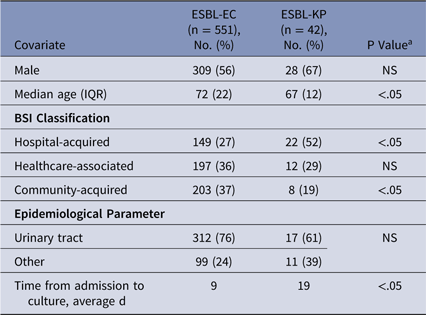To the Editor—The recent study by Scheuerman et al. Reference Scheuerman, Schechner and Carmeli1 investigating risk factors associated with extended-spectrum β-lactamase (ESBL)–producing Escherichia coli and ESBL-producing Klebsiella pneumoniae bloodstream infections was of interest to our group and spurred further investigation into local infection prevention and control surveillance data. Data were collected prospectively from acute care facilities within Alberta. The data were retrospectively analyzed for factors comparable to Scheuerman et al. Reference Scheuerman, Schechner and Carmeli1 including gender, age, case classification, time from admission to positive culture, and source of secondary infection. The data reflect all ESBL bloodstream infection cases in Alberta from April 2013 to March 2018, and our results are similar to the findings of Scheuerman et al. Reference Scheuerman, Schechner and Carmeli1 (Table 1) Of 593 ESBL isolates, 551 (93%) were E. coli. Of the cases that were extracted from our database, a statistically significant higher proportion of ESBL-producing K. pneumoniae bloodstream infections were classified as hospital acquired or healthcare associated with a longer average time from admission to culture than bloodstream infections with ESBL-producing E. coli. Conversely, a statistically significant higher proportion of ESBL E. coli bloodstream infection cases were noted to be community-acquired; only 19% of Klebsiella isolates were considered community-acquired.
The results obtained within Alberta are similar to the findings of Scheuerman et al. Reference Scheuerman, Schechner and Carmeli1 Going forward, future investigations may provide additional clarity on the differences between ESBL-producing isolates based on further study of clinical and nonclinical parameters, including the proportion of nonurine ESBL-producing E. coli isolates compared to ESBL-producing K. pneumoniae isolates, the appropriateness of initial antimicrobial therapy, and the travel history of patients with ESBL infections.
Table 1. Comparison of ESBL-EC and ESBL-KP BSI Case Characteristics, 2013–2018

Note. ESBL, extended-spectrum β-lactamase; EC, Escherichia coli; KP, Klebsiella pneumoniae; BSI, bloodstream infection; NS, not significant (P > .05).
a The Mann-Whitney U test was used to calculate P values for continuous variables. A test of proportions or the χ2 test was used for categorical variables.
Author ORCIDs
Kaitlin Hearn, 0000-0002-8201-7986
Acknowledgments
We acknowledge the infection control professionals and physicians of Alberta Health Services and Covenant Health for these surveillance data.
Financial support
No financial support was provided relevant to this article.
Conflicts of interest
All authors report no conflicts of interest relevant to this article.



